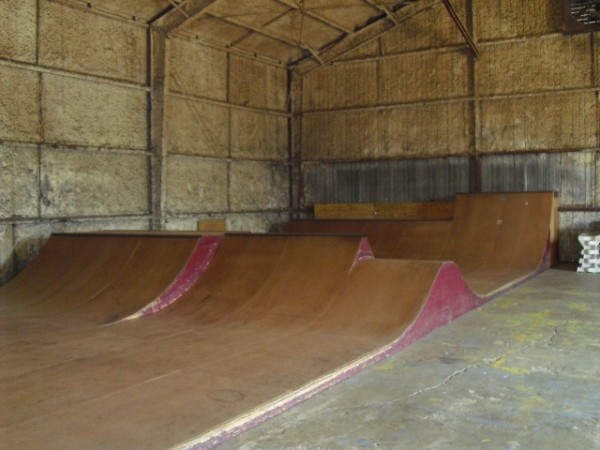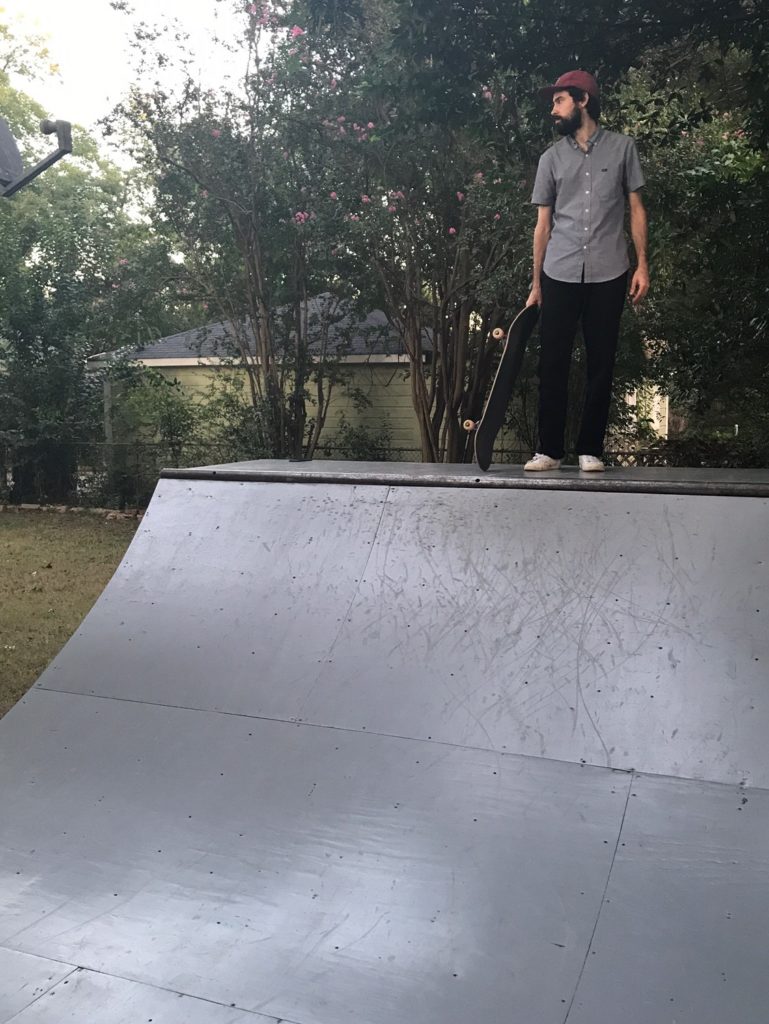At 14 years old, Thomas Woodruff first picked up a skateboard. It was 2001, and even though he had grown up practically next door to the Interskate skate park, he hadn’t thought to pick one up himself. Once he did, it was one of those life changing moments that don’t come very often. It felt right, like nothing had ever felt before. The wooden board, the metal trucks, the urethane wheels, it all came together in harmony as he stepped on and kicked off with his left foot. When Woodruff talks about skateboarding it is though he is talking about a childhood friend. He remembers the exact moment he fell in love with it, and said that it changed his entire life. “It changed the way I experienced the world,” he said. Everywhere he went, he would evaluate the landscape for skate-ability, and he would listen for the telltale sounds of skaters in the next block.
He started small at first, rolling around on his street, getting a feel for it, how to balance, how to kick. Before long he had mastered the basics, but he was looking for more of a challenge. He was curious to see how far he could go and to what extent he could push himself to be better. Soon he found himself at the Interskate skate park.
Interskate was the mecca for skaters in Shreveport and Bossier City back in the 90’s
The owners Byron and Stephanie opened it up as an oasis for skaters to flock to in the Deep South. They had recently moved from Indiana, and they had always wanted to own their own business. Byron knew the skating, and Stephanie knew the business side. They opened their park and shop that was inside of it in south Shreveport in the 1990’s, but towards the end of 2001 the relocated to Bossier, in a warehouse off Industrial Drive. Thomas no longer lived next door, but would convince his parents to make the 25 minute drive. With the new location came a new name: Holy Roller, which reflected the couples Christian values. At first, many of the skaters disliked the name because they felt it was “cheesy”. However the name grew on them as time went on.

HOLY ROLLER SKATEPARK & SHOP – Bossier City, Louisiana, U.S.A.
Unfortunately, the skaters couldn’t always make it to Holy Roller, so instead they would head downtown to skate the ledges and the stair sets. The business owners complained, and police started pushing the skateboarders out. The city even passed an ordinance banning skateboarding in any part of the downtown area. This left them with no place to go other than Holy Roller. The owners knew this, and they kept their prices low. It was all you could skate for $5 a day. It was wholesome too, they didn’t tolerate drugs or underage drinking. On Monday nights they held a bible study, and the kids who listened to the sermon were allowed to skate for free the rest of the night.
Even with ordinances forbidding skateboarding downtown, many skateboarders couldn’t resist. Woodruff said that some of the police were cool, and would just tell the kids to take it up the street, but others were strict and would issue citations, forcing the skaters to go to court. The battle for the right to skate downtown continued, so the City of Shreveport decided enough was enough, and agreed to build a municipal skate park on Stoner Avenue.
At that time, the skateboarding world was going through a renaissance, and half pipe skating fell out of favor for more street oriented tricks. The city officials in charge of designing and building the skate park were out of their element. They asked the leaders of the Shreveport skate scene, including Woodruff and his friends, to help with the design. What they came up with wasn’t a traditional skate park like the city imagined, it was a skate plaza. The ramps, half pipes, and transitions were out. Stairs, ledges, benches, and hand rails were in. At that time there was only one other skate plaza in the United States, in Kettering, Ohio. It had been built by Rob Dydrek.
Dydrek is a professional skateboarder who rose to mainstream fame through his TV shows Rob and Big, Fantasy Factory, and most recently Ridiculousness. At the time, Dydrek was crusading a campaign called Safe Spot Skate Spot, which was helping cities design and build skate plazas, in an effort to protect skaters, as well as provide education about skateboarding to the public. Dydrek was contacted, and agreed to help sponsor the Shreveport Skate Plaza project. The design was finalized, and work began.
Once construction began, the curious skateboarders who had been licking their lips to skate there went to see the construction. What they saw horrified them.
The city contractor and designers were creating some kind of concrete monster that was only loosely based on the design the skaters had given them. It was smaller than it was promised to be, the stairs were full of cracks, and the height of the ledges and rails were awkward and inaccessible. Once the park opened it became a haven for street people who would drink and use drugs there. Dydrek came down to examine the plaza once it was opened, and after seeing the disaster it was becoming, distanced himself from the project. His company, DC, even took the Stoner Ave plaza off of their website and washed their hands of the nightmare. Dydrek, years later, would return to Shreveport and apologize to the skaters for turning his back on them. He also invested some of his own money into partially refurbishing the plaza.
The plaza opened up, and the skaters gave it a shot, but it wasn’t a feasible option. The skaters decided to continue to skate downtown. The police rounded them up by force, angered that the skaters dared defy the city and continued to be a nuisance to local business owners.
With down town occupied by police, and the skate plaza more or less unusable, they flocked back to Holy Rollers. Woodruff started working there after school. At first he was the cleanup crew, sweeping the ramps, picking up trash, and cleaning the shop. The company didn’t raise prices to skate, so they relied heavily on the income they gained from the skate shop. They sold equipment, clothing, and shoes to keep the lights on.
In the mid-2000s, the park flourished. Woodruff and his friends began to make videos for the park. The videos featured local skaters from the SBC area performing tricks. Woodruff said he was doing everything he could to put Shreveport on the map. It was difficult, he said, as the middle of the country was more or less ignored by the skateboarding mainstream.
In 2012 Woodruff bought the skate park. Byron and Stephanie had decided to move on to bigger and better things, but they wanted to park to remain under control of someone who would appreciate it. At 25 years old, Woodruff found himself a business owner. It was something he had never dreamed of doing. He welcomed the challenge and was determined to keep the park going. Soon he couldn’t imagine doing anything else, skateboarding obsessed him. He started on a mission to change and update the park to attract more attention.
Indoor parks like Holy Roller began to disappear across the country. Thomas has hell-bent on keeping his park open. Wanting revamp the place, he began to make improvements. His goal was to completely redo most of the park with more modern pieces. There was one problem though, funding. Due to the low margins the park ran on, he could only afford to do a little bit at a time. He stayed busy, finding money where he could and doing much of the work himself in his off time.
The beginning of the end started when Zumiez skate shop came to the bossier mall. Zumiez is a major extreme sports store chain headquartered in California. They have the corporate power to buy items in bulk, and have deals with many major skateboarding companies, so they are able to offer items at cheaper rate then smaller shops. Woodruff said Zumiez has a reputation for putting locally owned skate shops out of business. People flocked to Zumiez once it opened. Finally there was a way for kids to look the part without living it. “I think people just wanted to look cool, walking out of the store with skate board in the mall. You can pretend all you want, because there’s no one to ask you to prove you can actually skate.”
Almost immediately, Thomas saw his profits start to dwindle. He wasn’t going to start charging the skaters more, to him that was unthinkable. Most of the skaters didn’t have much money, and he knew it was a pain to make the drive all they over from Shreveport. There was no other place for the, to go. Knowing this motivated Thomas to put his perceived duty to the community in front of his profit margin. He hoped to keep the park running on sheer will power.
He brainstormed and tried to search for a solution. He changed the name from Holy Roller to Sensory, a name he felt was his own, and encompassed the attitudes he had about skating into one simple word. Woodruff came up with name, explaining that skateboarding used most of your senses, you felt the board beneath your feet, you heard the “beautifully ugly” sounds as boards smashed against rails and chipped against ledges. You saw the world in a completely different way than other people do, everything is evaluated by the eye for skate-ability. Sensory was his was way of expressing everything he felt about the lifestyle he loved.

Woodruff stands on his ramp.
He liked the new name because it was more grown up, and hoped it would make the park be taken more seriously. With a name change it was clear, Thomas and the skaters were here to stay, and wouldn’t be intimidated by corporate greed. It infuriated Woodruff, who felt that Zumiez only cared about the bottom line. They weren’t a true skateboard company to Woodruff because their business model hurt the community they supposedly served.
Since Zumiez had Sensory beat on the major brands, Thomas looked to other avenues. He could offer a better variety of decks that Zumiez couldn’t. Through his numerous contacts, he was able to fill his shop with brands that were still underground and unknown to the majors. He gave small companies such as Polar a shot to sell their goods.
No good deed goes unpunished, and even though Woodruff had the will, he couldn’t afford to keep the park open. He recalls sitting down with his wife one night and venting about the struggles the park was having. She patted him on the back and explained no one can do it alone. She was right, and as the bills piled up, Woodruff had to close the doors on Sensory. It broke his heart, it was the death of his dream.
Thomas isn’t giving up. He works odd jobs around town, and his wife works to keep a roof over their family’s head. He’s also a film buff, and works part time at Sway Box studios in Shreveport. Still dedicated to the Shreveport skate scene, he built a mini ramp in his back yard. He skates it every day, and he welcomes his friends to come join, offering his own version of a safe spot skate spot. He isn’t retired by any means, just planning his return. He gave me an idea of what he’s working on, but I’ll let him make his announcement when he’s ready. Until then he continues on, doing whatever he can to keep the skateboard community in Shreveport alive.


